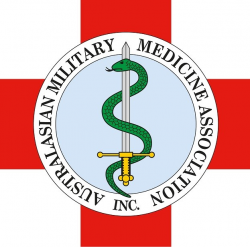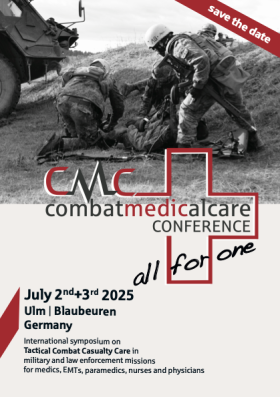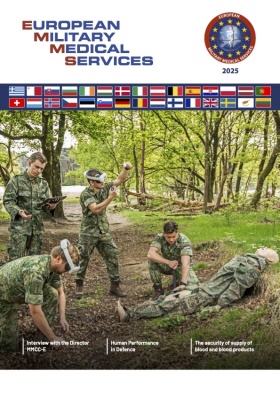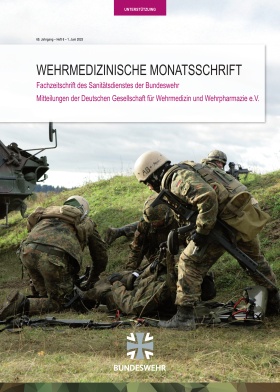
Article: Mikhailo Nikolaiev, Roman Kuziv, Iurii Mikheiev, Rusanov Ihor , Zhovtonozhko Oleksandr
Post-Tourniquet Syndrome in Military Personnel During Armed Conflicts in Ukraine
Introduction
Post-tourniquet syndrome (PTS) is one of the serious complications arising from the use of tourniquets in military settings. Tourniquets are life-saving tools used for emergency hemorrhage control and preventing fatal outcomes in combat injuries. However, improper or prolonged application may lead to severe consequences such as ischemic limb damage, neurological disorders, and reperfusion syndrome [1,6,7].
Relevance
The main complications of PTS include ischemia-reperfusion injury, rhabdomyolysis, neuropathy, and thrombosis, which may result in long-term disability or even amputation [4,5].
According to Kragh, J. F. et al., tourniquet application lasting more than two hours significantly increases the risk of ischemic tissue damage, and once the tourniquet is removed, the release of toxic metabolites causes reperfusion syndrome. Another study by Brodie, S. et al., showed that tourniquet use in combat leads to long-term neuropathies in 30% of cases, requiring prolonged recovery. Combined pharmacological treatment, such as antioxidants and vasodilators, may reduce the severity of reperfusion damage and improve rehabilitation outcomes [1,2,3].
Timely diagnosis and appropriate treatment of PTS highlight the need for deeper study of this issue. This experience underscores the importance of proper tourniquet use for life-threatening hemorrhage control and the continuous training of medical personnel.
Aim
To evaluate the prevalence, clinical features, and preventive strategies for post-tourniquet syndrome in military personnel injured during armed conflicts. Another key goal is to determine optimal prevention strategies for PTS.
Materials and Methods
In 2024, 196 cases of military personnel were analyzed. They were brought to forward surgical teams (FSTs) from one of the directions of the front line, with tourniquets applied to limbs resulting in complications due to post-tourniquet syndrome. The total number of wounded who received medical care at Role 2 facilities was assessed. The frequency of PTS among all wounded was 1.16%. The average tourniquet time (corresponding to evacuation time from the front line) in severely injured patients was 14.9 hours (range: 2–96 hours), and in lightly to moderately injured — 35 hours (range: 1–456 hours). About 70% of injuries were caused by the enemy’s use of FPV drones.
Among these cases, 64.29% required limb amputation above the tourniquet site due to irreversible ischemic changes. (Fig. 1)
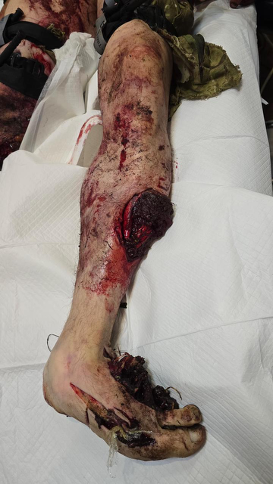
Figure 1. Ischemic changes in the lower limb
source: Mykhailo Nikolaiev
Ischemic changes were assessed through a comprehensive evaluation, including the presence of limb contractures, determination of tourniquet efficacy using Doppler ultrasonography of the peripheral vasculature, assessment of muscle contractility via neuromuscular electrical stimulation (Fig. 2), and calculation of the Mangled Extremity Severity Score (MESS).
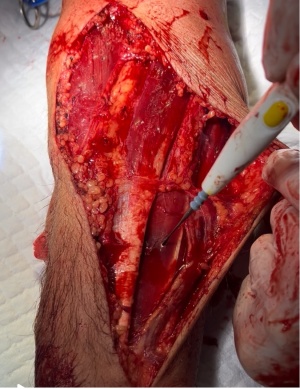
Figure 2. Neuromuscular electrical stimulation
source: Mykhailo Nikolaiev
Out of 196 PTS cases, 126 patients (64.29%) underwent limb amputations:
- Upper limbs:28 cases (14.29%)
- Right limb – 16 cases (8.16%)
- Left limb – 12 cases (6.12%)
- Lower limbs: 98 cases (50.0%)
- Both limbs – 13 cases (6.63%)
- Right limb – 41 cases (20.92%)
- Left limb – 44 cases (22.45%)
Limb-Sparing Surgical Interventions
In 70 cases (35.71%), limb-preserving surgeries were performed, including vascular procedures, fasciotomy, or use of external fixation devices (EFDs). (Fig. 3)
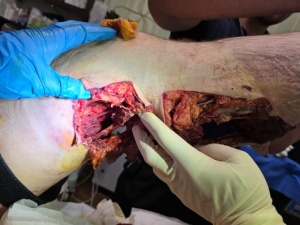
Figure 3. Tourniquet conversion and rapid evacuation — limb preserved
source: Mykhailo Nikolaiev
Main results:
- Upper limbs:19 cases (9.69%)
- Right limb – 11 cases (5.61%)
- Left limb – 7 cases (3.57%)
- Both limbs – 1 case (0.51%)
- Lower limbs:51 cases (26.02%)
- Both limbs – 2 cases (1.02%)
- Right limb – 26 cases (13.27%)
- Left limb – 23 cases (11.73%)
Results
Prolonged tourniquet time resulted in amputation in 64% of cases; limb preservation was possible in 36%. Compared to the data presented by F. Butler et al. [7], the average tourniquet application time was significantly longer (14.9 hours vs. 3.4 hours), which is attributed to complicated evacuation from the frontline. A similar trend was observed in the limb amputation rate (64% vs. 3.7%). However, a reduction in the overall number of PTS cases was observed (2.07% in 2023 vs. 1.16% in 2024), likely due to more differentiated tourniquet use and better training among combat medics and soldiers.
The findings indicate that limb preservation below the tourniquet is often impossible due to irreversible ischemic changes, leading to the need for long-term treatment, prosthetics, and rehabilitation. Even when limbs are preserved, ischemia-reperfusion injury, rhabdomyolysis, neuropathy, and thrombosis often cause significant functional impairment and disability.
The primary reason for delayed evacuation is the enemy’s use of FPV drones. Improving protection against such threats is a top priority and a potential solution to this problem.
Conclusions
- Post-tourniquet syndrome remains a complication that, in most cases, leads to limb amputation.
- Even in cases where limbs are preserved, ischemic changes such as contractures and neuropathies persist.
- Lower limbs suffered the most damage — 50% of cases resulted in amputation.
- PTS requires further analysis to develop effective prevention methods and strategies for limb preservation once the syndrome is diagnosed.
- Evacuation time from the combat zone plays a key role in limb salvage.
References
- Kragh, J. F., Walters, T. J., Westmoreland, T., Miller, R. M., Mabry, R. L., Kotwal, R. S., Ritter, B. A., Hodge, D. C., Greydanus, D. J., Cain, J. S., Parsons, D. L., Edgar, E. P., Harcke, D. J., Baer, D. G., Dubick, M. A., Blackbourne, L. H., Montgomery, H. R., Holcomb, J. B., & Butler, F. K. Jr. (2013, Fall). Tragedy into drama: An American history of tourniquet use in the current war. Journal of Special Operations Medicine, 13(3), 5–25. https://doi.org/10.55460/QN66-A9MG
- Brodie, S., Hodgetts, T. J., Ollerton, J., Mahoney, P., & Russell, R. (2007). Tourniquet use in combat trauma: UK military experience. BMJ Military Health, 153(4), 310–313. https://doi.org/10.1136/jramc-153-04-12
- Butler, F. K. (2015, Winter). Military history of increasing survival: The U.S. military experience with tourniquets and hemostatic dressings in the Afghanistan and Iraq conflicts. Journal of Special Operations Medicine, 15(4), 149. https://doi.org/10.55460/DXBQ‑YHD0
- Schauer, S. G., April, M. D., Fisher, A. D., Cunningham, C. W., & Gurney, J. M. (2018). Junctional tourniquet use during combat operations in Afghanistan: The prehospital trauma registry experience. Journal of Special Operations Medicine, 18(2), 71–74. https://doi.org/10.55460/SXCY‑5SCX
- Klotz JK, Leo M, Andersen BL, et al. First case report of SAM(r) Junctional tourniquet use in Afghanistan to control inguinal hemorrhage on the battlefield. Journal of Special Operations Medicine : a Peer Reviewed Journal for SOF Medical Professionals. 2014 ;14(2):1-5. DOI: 10.55460/yfse-v7we. PMID: 24952032.
- Vladyslav Yatsun, Application of Hemostatic Tourniquet on Wounded Extremities in Modern “Trench” Warfare: The View of a Vascular Surgeon, Military Medicine, Volume 189, Issue 1-2, January/February 2024, Pages 332–336, https://doi.org/10.1093/milmed/usac208
- Butler, Frank MD, FAAO, FUHM; Holcomb, John B. MD, FACS; Dorlac, Warren MD, FACS; Gurney, Jennifer MD, FACS; Inaba, Kenji MD, FACS; Jacobs, Lenworth MD, MPH, FACS; Mabry, Bob MD, FACEP; Meoli, Mike AS; Montgomery, Harold BBA; Otten, Mel MD, FACEP; Shackelford, Stacy MD, FACS; Tadlock, Matthew D. MD, FACS; Wilson, Justin EMTP; Humeniuk, Kostiantyn MD; Linchevskyy, Oleksandr MD, PhD; Danyliuk, Oleksandr MD. Who needs a tourniquet? And who does not? Lessons learned from a review of tourniquet use in the Russo-Ukrainian war. Journal of Trauma and Acute Care Surgery 97(2S):p S45-S54, August 2024. | DOI: 10.1097/TA.0000000000004395
Author Contributions:
Mikhailo Nikolaiev – conceptualization, methodology;
Roman Kuziv – software, formal analysis;
Iurii Mikheiev – data validation, writing – original draft;
Rusanov Ihor – writing – review and editing;
Zhovtonozhko Oleksandr – visualization, editing, reference curation.
Date: 09/11/2025

